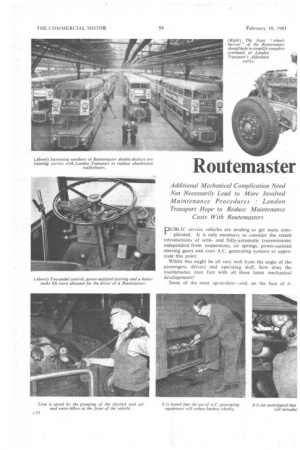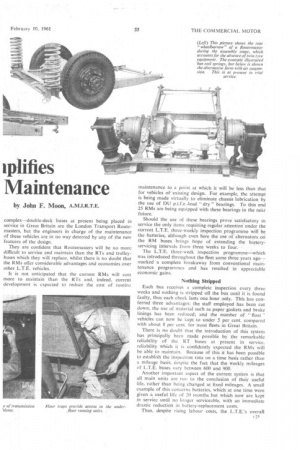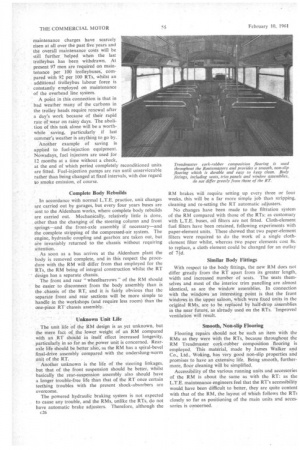Routemaster tplifies Maintenance
Page 62

Page 63

Page 64

If you've noticed an error in this article please click here to report it so we can fix it.
by John F. Moon, A.M.I.R.T.E.
Additional Mechanical Complication Need Not Necessarily Lead to More Involved Maintenance Procedures : London Transport Hope to Reduce Maintenance Costs With Routemasters
PUBLIC service vehicles are tending to get more corn
plicated. It is only necessary to consider the recent introductions of semiand fully-automatic transmissions, independent front suspensions, air springs, power-assisted steering gears and even A.C. generating systems to appreciate this point.
Whilst this might be all very well from the angle of the passengers, drivers and operating staff, how does the maintenance man fare with all these latest mechanical developments?
Some of the most up-to-date—and, on the face of it. complex—double-deck buses at present being placed in service in Great Britain are the London Transport Routemasters, but the engineers in charge of the maintenance of these vehicles are in no way deterred by any of the new features of the design.
They are confident that Routemasters will be no more difficult to service and maintain than the RTs and trolleybuses which they will replace, whilst there is no doubt that the RMs offer considerable advantages and economies over other L.T.E. vehicles.
it is not anticipated that the current RMs will cost more to maintain than the RTs and, indeed, current development is expected to reduce the cost of routine maintenance to a point at which it will be less than that for vehicles of'existing design. For example, the attempt is being made virtually to eliminate chassis lubrication, by the use of DU p.t.f.e.-lead "dry "bearings. To this end 25 RMs are being equipped with these bearings in the near future.
Should the use of these bearings prove satisfactory in service the only items requiring regular attention under the current L.T.E. three-weekly inspection, programme will be the batteries, although even here the use of -alternatOrs on the RM buses brings hope of .extending the battery= servicing intervals from three Weeks to four. .
The L.T.E. three-week inspection programmewhich was introduced throughout the fleet some three years ago-7marked a complete breakaway from conventional Maintenance programmes and has resulted. in . appreciable economic gains.
Nothing Stripped Each bus receives a complete inspection every three weeks and nothing is stripped off the bus until it is found faulty, thus each check lasts one hour Only. This has conferred three advantages: the staff employed .-has: been cut down; the use of material such as paper gaskets and brake linings has been reduced; and the number of "float vehicles can now be kept to under 5 per cent, compared with about 8 per cent, for most fleets in Great Britain.
There is no doubt that the introduction of this system has principally been made possible by the remarkable reliability of the RT buses at 'present . in service, reliability which it is confidently expected the RMs will be able to maintain. Because of this it has been possible to establish the inspection rOta on a time basis rather than a mileage basis, despite the fact that the weekly mileages of L.T.E. buses vary between 600 and 900. . .
Another important aspect of the current system is that all main units are run to the conclusion of their useful life, rather than being changed at fixed mileages. .A small example of this concerns batteries, which-at one time were given a useful life of 20 months but which now are kept in service until no longer serviceable, with an immediate drastic reduction in battery-replacement costs.
Thus, despite rising labour costs, the L.T.E.'s overall maintenance charges have scarcely risen at all over the past five years and the overall maintenance costs will be still further helped when the last trolleybus has been withdrawn. At present 97 men are required on maintenance per 100 trolleybuses, corn'pared with 92 per 100 RTs, whilst an • • additional trolleybus labour force is constantly employed on maintenance of the overhead line system.
A point in this connection is that in bad weather many of the carbons in the trolley heads require renewal after a day's work because of their rapid rate of wear on rainy days. The abolition of this task alone will be a worthwhile saving, particularly if last summer's weather is anything to go by.
Another example of saving is applied to fuel-injection equipment. Nowadays, fuel injectors are used for 12 months at a time without a check, at the end of which period completely reconditioned units are fitted. Fuel-injection pumps are run until unserviceable rather than being changed at fixed intervals, with due regard to smoke emission, of course.
Complete Body Rebuilds
In accordance with normal L.T.E. practice, unit changes are carried out by garages, but every four years buses are sent to the Aldenham works, where complete body rebuilds are carried out. Mechanically, relatively little is done, other than the changing of the steering column and front springs—and the front-axle assembly if necessary—and the complete stripping of the compressed-air system. The engine, hydraulic coupling and gearbox are taken out, but are invariably returned to the chassis without requiring attention, As soon as a bus arrives at the Aldenham plant the body is removed complete, and in this respect the procedure with the RM will differ from that employed for the RTs, the RM being of integral construction whilst the RT design has a separate chassis.
The front and rear "wheelbarrows" of the RM should be easier todisconnect from the body assembly than is the chassis of the RT, and it. is fairly obvious that the separate front and rear sections will be more simple to handle in the workshops (and require less room) than the one-piece RT chassis assembly.
Unknown Unit Life .
The unit life of the RM design is as yet unknown, but the mere fact of the lower weight of an RM compared 'with an RT should in itself effect increased longevity, particularly in so far as the power unit is concerned. Rearaxle life should be better also, as the RM has a spiral-bevel final-drive assembly compared with the underslung-worm unit of the RT.
Another unknown is the life of the steering linkages. but that of the front suspension should be better, whilst basically the rear-suspension assembly also should have a longer trouble-free life than that of the RT once certain teething troubles with the present shock-absorbers are overcome.
The powered hydraulic braking system is not expected to cause any trouble, and the RMs, unlike the RTs, do not have automatic brake adjusters. Therefore, although the c26 RM brakes will require setting up every three or four weeks, this will be a far more simple job than stripping, cleaning and re-setting the RT automatic adjusters.
No changes have been made to the filtration system of the RM compared with those of the RTs: as customary with L.T.E. buses, oil filters are not fitted. Cloth-element fuel filters have been retained, following experiments with paper-element units. These showed that two paper-element filters were required to do the work of a single clothelement filter whilst, whereas two paper elements cost 8s. to replace, a clothelement could be changed for an outlay of 71d.
Similar Body Fittings
With respect to the body fittings, the new RM does not differ greatly from the RT apart from its greater length, width and increased number of seats. The seats themselves and most of the interior trim panelling are almost identical, as are the window assemblies. In connection with the windows an interesting point is that the front windows in the upper saloon, which were fixed units in the original RMs, are to be replaced by half-drop assemblies in the near future, as already used on the RTs. Improved ventilation will result.
Smooth, Non-slip Flooring
Flooring repairs should not be such an item with the RMs as they were with the RTs, because throughout the RM Treadmaster cork-rubber composition flooring is employed. This material, made by James Walker and Co., Ltd., Woking, has very good non-slip properties and promises to have an extensive life, Being smooth, furthermore, floor cleaning will be simplified.
Accessibility of the various running units and accessories of the RM is about the same as with the RT: as the L.T.E. maintenance engineers feel that the RT's accessibility would, have been difficult to better, they are quite content with that of the RM, the layout of which follows the RTs closely so far as positioning of the main units and accessories is concerned.




























































































































